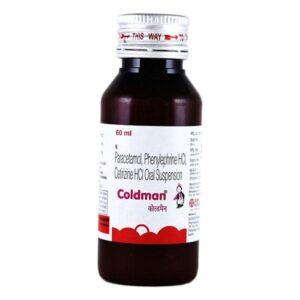AMBROXOL + TERBULATINE
Ambroxol: Ambroxol is a drug that is primarily used as an expectorant to help loosen and expel mucus from the respiratory tract. It is commonly prescribed for the treatment of various respiratory conditions such as chronic obstructive pulmonary disease (COPD), asthma, bronchitis, and pneumonia.
The main mechanism of action of Ambroxol is its ability to stimulate the production of a substance called surfactant in the lungs. Surfactant plays an important role in reducing the viscosity of mucus, making it easier to cough up and clear from the airways. Additionally, Ambroxol exhibits antioxidant and anti-inflammatory effects, which can help relieve respiratory symptoms and improve lung function.
The usual dose of Ambroxol depends on the specific condition being treated. For adults and children over 12 years old, the typical dose is 30 mg to 120 mg per day, divided into 2-3 doses. Children between 6-12 years old generally take 15 mg to 60 mg per day, and children under 6 years old may receive 7.5 mg to 30 mg per day. The dose can vary based on the severity of the condition and the individual’s response to treatment, so it’s important to follow the doctor’s instructions or the instructions on the package.
While Ambroxol is generally well-tolerated, it can still cause some side effects. Common side effects may include nausea, diarrhea, stomach discomfort, headache, dizziness, or skin rash. In rare cases, more serious allergic reactions can occur, characterized by symptoms like difficulty breathing, swelling, or severe skin reactions. If any side effects occur or worsen, it’s important to consult a healthcare professional for further guidance.
Additionally, Ambroxol may interact with certain medications, so it’s important to inform your doctor about any other drugs you are taking to prevent potential interactions or contraindications.
Overall, Ambroxol is a commonly used and effective expectorant medication that helps to alleviate respiratory conditions by loosening and expelling mucus, reducing inflammation, and improving lung function. It should be used under the guidance of a healthcare professional to ensure safe and effective treatment.
Terbulatine: Terbutaline is a medication primarily used to treat asthma, chronic obstructive pulmonary disease (COPD), and preterm labor. It belongs to a class of drugs called beta-2 adrenergic agonists.
The main mechanism of action of terbutaline is its ability to stimulate the beta-2 adrenergic receptors in the smooth muscles of the airways and uterus. By binding to these receptors, it causes the muscles to relax, thereby providing bronchodilation in the case of asthma and COPD, and uterine relaxation in the case of preterm labor.
In asthma and COPD, terbutaline is usually administered through an inhaler or nebulizer to provide quick relief of symptoms such as wheezing, shortness of breath, and chest tightness. The dosage varies depending on the severity of the condition, but it is typically recommended to use 1 to 2 inhalations every 4 to 6 hours as needed. It is important to follow the prescribed dosage and frequency guidelines given by a healthcare professional.
For preterm labor, terbutaline can be administered intravenously in a hospital setting. The recommended dose is usually determined by a doctor based on the individual’s specific condition.
Like any medication, terbutaline can have side effects. Some common side effects include tremors, rapid heartbeat (tachycardia), headache, nervousness, dizziness, and muscle cramps. These side effects are usually mild and temporary. However, if any of these side effects become severe or persist, it is important to seek medical attention.
In some cases, terbutaline can lead to more serious side effects such as chest pain, irregular heartbeat, seizures, allergic reactions, or high blood sugar levels. If any of these occur, immediate medical attention should be sought.
It is important to note that terbutaline should be used under the guidance and prescription of a healthcare professional. They will determine the appropriate dosage and monitor the individual’s response to the medication to ensure its safety and effectiveness.

